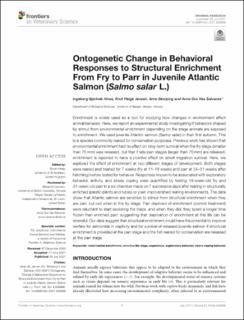| dc.contributor.author | Alnes, Ingeborg Bjerkvik | |
| dc.contributor.author | Jensen, Knut Helge | |
| dc.contributor.author | Skorping, Arne | |
| dc.contributor.author | Salvanes, Anne Gro Vea | |
| dc.date.accessioned | 2022-04-07T11:45:18Z | |
| dc.date.available | 2022-04-07T11:45:18Z | |
| dc.date.created | 2022-01-29T13:57:47Z | |
| dc.date.issued | 2021 | |
| dc.identifier.issn | 2297-1769 | |
| dc.identifier.uri | https://hdl.handle.net/11250/2990523 | |
| dc.description.abstract | Enrichment is widely used as a tool for studying how changes in environment affect animal behavior. Here, we report an experimental study investigating if behaviors shaped by stimuli from environmental enrichment depending on the stage animals are exposed to enrichment. We used juvenile Atlantic salmon (Salmo salar) in their first autumn. This is a species commonly reared for conservation purposes. Previous work has shown that environmental enrichment had no effect on long-term survival when the fry stage (smaller than 70 mm) was released, but that if late parr stages (larger than 70 mm) are released, enrichment is reported to have a positive effect on smolt migration survival. Here, we explored the effect of enrichment at two different stages of development. Both stages were reared and treated for 7 weeks (fry at 11–18 weeks and parr at 24–31 weeks after hatching) before tested for behavior. Responses known to be associated with exploratory behavior, activity, and stress coping were quantified by testing 18-week-old fry and 31-week-old parr in a six-chamber maze on 7 successive days after rearing in structurally enriched (plastic plants and tubes) or plain impoverished rearing environments. The data show that Atlantic salmon are sensitive to stimuli from structural enrichment when they are parr, but not when in the fry stage. Parr deprived of enrichment (control treatment) were reluctant to start exploring the maze, and when they did, they spent a longer time frozen than enriched parr, suggesting that deprivation of enrichment at this life can be stressful. Our data suggest that structural enrichment could have the potential to improve welfare for salmonids in captivity and for survival of released juvenile salmon if structural enrichment is provided at the parr stage and the fish reared for conservation are released at the parr stage. | en_US |
| dc.language.iso | eng | en_US |
| dc.publisher | Frontiers | en_US |
| dc.rights | Navngivelse 4.0 Internasjonal | * |
| dc.rights.uri | http://creativecommons.org/licenses/by/4.0/deed.no | * |
| dc.title | Ontogenetic Change in Behavioral Responses to Structural Enrichment From Fry to Parr in Juvenile Atlantic Salmon (Salmo salar L.) | en_US |
| dc.type | Journal article | en_US |
| dc.type | Peer reviewed | en_US |
| dc.description.version | publishedVersion | en_US |
| dc.rights.holder | Copyright 2021 The Author(s) | en_US |
| dc.source.articlenumber | 638888 | en_US |
| cristin.ispublished | true | |
| cristin.fulltext | original | |
| cristin.qualitycode | 1 | |
| dc.identifier.doi | 10.3389/fvets.2021.638888 | |
| dc.identifier.cristin | 1993134 | |
| dc.source.journal | Frontiers in Veterinary Science | en_US |
| dc.identifier.citation | Frontiers in Veterinary Science. 2021, 8, 638888. | en_US |
| dc.source.volume | 8 | en_US |

